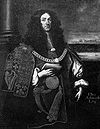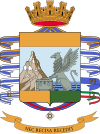Welcome to the Heraldry and Vexillology Portal!


Heraldry encompasses all of the duties of a herald, including the science and art of designing, displaying, describing and recording coats of arms and badges, as well as the formal ceremonies and laws that regulate the use and inheritance of arms. The origins of heraldry lie in the medieval need to distinguish participants in battles or jousts, whose faces were hidden by steel helmets.
Vexillology (from the Latin vexillum, a flag or banner) is the scholarly study of flags, including the creation and development of a body of knowledge about flags of all types, their forms and functions, and of scientific theories and principles based on that knowledge. Flags were originally used to assist military coordination on the battlefield, and have evolved into a general tool for signalling and identification, particularly identification of countries.
Selected article
Ireland King of Arms was the title of an Irish officer of arms from 1392 until the accession of Henry VII as King of England in 1485. The office was replaced in 1552 by that of Ulster King of Arms, which in 1943 was merged with Norroy King of Arms forming the present office of Norroy and Ulster King of Arms. In theory, Ireland King of Arms enjoyed heraldic jurisdiction in the whole of the Lordship of Ireland. (more...)
Selected biography

Elias Ashmole was an antiquarian, collector, politician and officer of arms. He supported the royalist side during the English Civil War, and at the restoration of Charles II he was rewarded with several lucrative offices, including Windsor Herald of Arms in Ordinary. Throughout his life he was an avid collector of curiosities and other artifacts. Many of these he acquired from the traveller, botanist, and collector John Tradescant the elder and his son of the same name, and most he donated to Oxford University to create the Ashmolean Museum. He also donated his library and priceless manuscript collection to Oxford. Apart from his collecting activities, Ashmole illustrates the passing of the pre-scientific world view in the seventeenth century: while he immersed himself in alchemical, magical and astrological studies and was consulted on astrological questions by Charles II and his court, these studies were essentially backward-looking. Although he was one of the founding members of the Royal Society, a key institution in the development of experimental science, he never participated actively. (more...)
Selected flag

The Flag of Europe is the flag and emblem of the European Union (EU) and Council of Europe (CoE) (it is also used to indicate the euro or eurozone countries). It consists of a circle of 12 golden (yellow) stars on a blue background. The blue represents the west; the number of stars represents completeness while their position in a circle represents unity. The stars do not vary according to the members of either organisation as they are intended to represent all the peoples of Europe, even those outside European integration.
The flag was designed by Arsène Heitz and Paul Lévy in 1955 for the CoE as its symbol, and the CoE urged it to be adopted by other organisations. In 1985 the EU, which was then the European Economic Community (EEC), adopted it as its own flag (having had no flag of its own before) at the initiative of the European Parliament. The flag is not mentioned in the EU's treaties, its incorporation being dropped along with the European Constitution, but it is formally adopted in law. (more...)
Selected picture

Pursuivants in procession to St George's Chapel, Windsor Castle for the 2006 service of the Order of the Garter: Peter O'Donoghue, Bluemantle Pursuivant of Arms in Ordinary (left), Alastair Bruce of Crionaich, Fitzalan Pursuivant of Arms Extraordinary (right).
Did you know...
- ...that the Italian mountain Cimon della Pala appears on the coat of arms of the Guardia di Finanza (pictured)?
- ...that British politician Jock Stallard was expelled from the Labour Party in the 1950s for flying the red flag from St Pancras town hall, but later served as a Labour MP and life peer?
- ...that the Dering Roll begins with the coats of arms of two illegitimate sons of King John of England?
- ...that the international maritime signal flags developed by Home Riggs Popham are also used in the Racing Rules of Sailing?
- ...that Hinke Bergegren's Under röd flagg was the first periodical to introduce detailed accounts of anarchist thought in Sweden?
Related portals
Heraldry Web resources
Authorities
- Belgium - The Council of Nobility, Flemish Heraldic Council and Council of Heraldry and Vexillology of the French Community
- Canada - Canadian Heraldic Authority and see also Public Register of Arms, Flags and Badges
- England, Wales, and Northern Ireland - The College of Arms
- Ireland - The Office of the Chief Herald of Ireland
- Netherlands - High Council of Nobility
- Portugal - Instituto da Nobreza Portuguesa
- Scotland - The Court of the Lord Lyon
- South Africa - South African Bureau of Heraldry
- Sweden - National Board of Heraldry, The National Archive
- United States Army - The United States Army Institute of Heraldry
Societies
- Greek Heraldry Society
- The Academy of Heraldic Science Czech republic
- The American College of Heraldry
- The American Heraldry Society
- The Augustan Society
- The Australian Heraldry Society Inc.
- Bulgarian Heraldry and Vexillology Society
- The Center for Research of Orthodox Monarchism
- Cambridge University Heraldic and Genealogical Society
- Chiltern Heraldry Group
- The College of Dracology
- Croatian Heraldic and Vexillologic Association
- The Finnish Heraldic Society
- Fryske Rie foar Heraldyk
- Hellenic Armigers Society
- Guild of Heraldic Artists
- Genealogical Society of Ireland
- Heraldry Research Institute (Japan)
- The Heraldry Society
- The Heraldry Society of Africa
- The Heraldry Society of New Zealand Inc.
- The Heraldry Society of Scotland
- The Heraldry Society of Southern Africa
- The Institute of Heraldic and Genealogical Studies
- The International Association of Amateur Heralds
- Italian Center of Vexillological Studies
- Lancashire Heraldry Group
- Macedonian Heraldry Society
- New England Historic Genealogical Society Committee on Heraldry
- Norwegian Heraldry Society
- Oxford University Heraldry Society
- Polish Heraldry Society
- Polish Nobility Confederation
- Real Academia Matritense de Heráldica y Genealogía - Royal Academy of Heraldry and Genealogy of Madrid
- Romanian Institute for Genealogy and Heraldry
- The Royal Heraldry Society of Canada
- The Russian College of HeraldryThe Russian College of Heraldry
- Serbian Heraldic Society
- Societas Heraldica Scandinavica
- Societas Heraldica Slovenica
- Swedish Heraldic Society
- Ukrainian Heraldry Society
- Royal Association Genealogical and Heraldic Office of Belgium
Vexillology
Software
- Coat of Arms Visual Designer web-based program
- Puncher Heraldry Program
- Blazonry Server - pyBlazon
- DrawShield - creates SVG shield or arms image from blazon
- CoaMaker - web-based tool
- Blazon95 and BLAZONS! 2000, older Windows applications
Texts
- Heraldry, historical and popular : with seven hundred illustrations (1863)
- A Complete Guide to Heraldry (1909)
Other
Wikimedia
The following Wikimedia Foundation sister projects provide more on this subject:
- Commons
Free media repository - Wikibooks
Free textbooks and manuals - Wikidata
Free knowledge base - Wikinews
Free-content news - Wikiquote
Collection of quotations - Wikisource
Free-content library - Wikispecies
Directory of species - Wikiversity
Free learning tools - Wikivoyage
Free travel guide - Wiktionary
Dictionary and thesaurus











